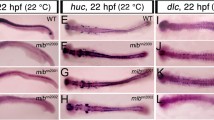Summary
Two coding regions were identified within a 110 kb region which includes all mappedBar breakpoints. Both lie proximal to the identifiedBar breakpoints. The first coding region, designatedBarA, is 5 kb from the most proximalBar mutation,B 581, and 66 kb from theB S breakpoint. It encodes a 1.3 kb transcript, which is found in late third instar larvae but is absent in 1–3-day-old pupae.B i,R(B) hd3,B 85c1s andB S result in overproduction of this transcript in late third instar larvae. A second coding region, which was previously identified asBarH1, maps 18 kb fromB 581 and 79 kb from theB S breakpoint. In third instar larvae, the abundance of theBarH1 transcript is very low in both wild type and variousBar mutatants, with the exception of R(B)hd3. In 1–3-day-old pupae, the level of theBarH1 transcript is higher.BarH1 was previously identified as theBar gene. However, this report raises the possibility thatBarA rather thanBarH1 is theBar gene or that more than one gene may be involved in Bar position effects.
Similar content being viewed by others
References
Bingham PM, Levis R, Rubin GM (1981) Cloning of DNA sequences from thewhite locus ofD. melanogaster by a novel and general method. Cell 25:693–704
Bridges CB (1936) The Bar “gene” a duplication. Science 83:210–211
Brosseau GE, Nicoletti B, Grell EH, Lindsley DL (1961) Production of altered Y chromosomes bearing specific sections of the X chromosome inDrosophila. Genetics 46:339–346
Fristrom D (1969) Cellular degeneration in the production of some mutant phenotypes inDrosophila melanogaster. Mol Gen Genet 103:363–379
Fristrom D (1972) Chemical modification of cell death in the Bar eye of Drosophila. Mol Gen Genet 115:10–18
Griffin AB (1941) TheB s translocation inD. melanogaster and modifications of theBar effect through irradiation. Genetics 26:154–155
Grosschedl R, Weaver D, Baltimore D, Constantini F (1984) Introduction of a μ immunoglobulin gene into the mouse germ line: Specific expression in lymphoid cells and synthesis of functional antibody. Cell 38:647–658
Hazelrigg T, Levis R, Rubin G (1984) Transformation ofwhite locus DNA inDrosophila: dosage compensation,zeste interaction, and position effects. Cell 36:469–481
Keppy D, Welshons W (1977) The cytogenetics of a recessive visible mutant associated with a deficiency adjacent to theNotch locus inDrosophila melanogaster. Genetics 85:497–506
Kojima T, Ishimaru S, Higashijima S, Takayama E, Akimaru H, Sone M, Emori Y, Saigo S (1991) Identification of a differenttype homeobox gene,BarH1, possibly causingBar (B) andOm(1D) mutations inDrosophila. Proc Natl Acad Sci USA 88:4343–4347
Lewis EB (1950) The phenomenon of position effect. Adv Genet 3:73–115
Lindsley DL, Grell EH (1968) Genetic variations ofDrosophila melanogaster. Carnegie Inst Wash Publ 627
Maniatis T, Hardison RC, Lacy E, Lauer J, O'Connell C, Quon D, Sim DK, Estradiatis A (1978) The isolation of structural genes from libraries of eukaryotic DNA. Cell 15:687–701
Mozer B, Marlor R, Parkhurst S, Corces V (1985) Characterization and developmental expression of aDrosophila ras oncogene. Mol Cell Biol 5:885–889
Muller HJ, Prokofyeva-Belgovskaya AA, Kossikov KV (1936) Unequal crossing-over in theBar mutant as a result of duplication of a minute chromosome section. (CR Doklady). Acad Sci USSR 1: 87–88
Sanger F, Nicklen S, Coulson AR (1977) DNA sequencing with chain-terminating inhibitors. Proc Natl Acad Sci USA 74:5463–5467
Spradling A, Rubin G (1983) The effect of chromosomal position on the expression of theDrosophila xanthine dehydrogenase gene. Cell 34:47–57
Sturtevant AH (1925) The effects of unequal crossing over at theBar locus inDrosophila. Genetics 10:117–147
Sutton E (1943)Bar eye inDrosophila melanogaster: a cytological analysis of some mutations and reverse mutations. Genetics 28:97–107
Swift G, Hammer R, MacDonald R, Brinster R (1984) Tissuespecific expression of the rat pancreatic elastase I gene in transgenic mice. Cell 38:38:639–646
Tanda S, Corces VG (1991) Retrotransposon-induced overexpression of a homeobox gene causes defects in eye morphogenesis inDrosophila. EMBO J 10:407–417
Tanda S, Shrimpton AE, Hinton CW, Langley CH (1989) Analysis of theOm(1D) locus inDrosophila ananassae. Genetics 123:495–502
Tice SC (1914) A new sex-linked character inDrosophila. Biol Bull 26:221–230
Tsubota SI, Rosenberg D, Szostak H, Rubin D, Schedl P (1989) The cloning of theBar region and theB breakpoint inDrosophila melanogaster: evidence for a transposon-induced rearrangement. Genetics 122:881–890
Author information
Authors and Affiliations
Additional information
Communicated by M. Ashburner
Rights and permissions
About this article
Cite this article
Norris, E., Sanders, M., Crumety, V. et al. The identification of theB S breakpoint and of two possibleBar genes. Molec. Gen. Genet. 233, 106–112 (1992). https://doi.org/10.1007/BF00587567
Received:
Issue Date:
DOI: https://doi.org/10.1007/BF00587567




